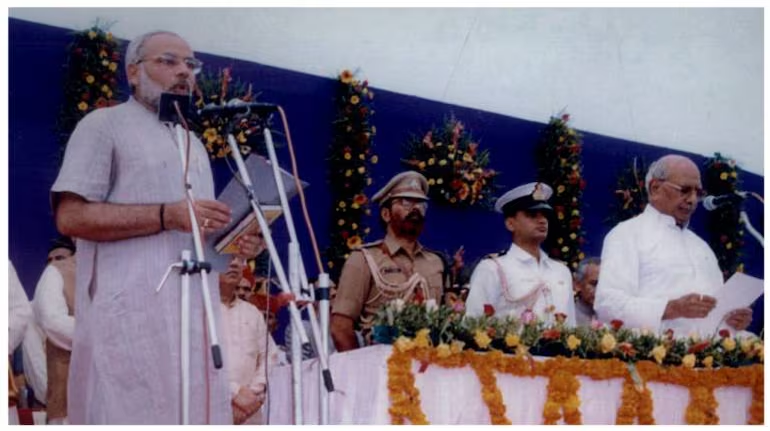
Introduction
Narendra Modi served as the Chief Minister (CM) of Gujarat from October 7, 2001, to May 2014, making him one of the longest-serving CMs in the state’s history. His leadership transformed Gujarat into a hub for economic growth, industrial development, and governance reforms. This article explores his journey as Gujarat’s CM, key elections, policies, and governance strategies that shaped his tenure.
Taking Office as Gujarat’s Chief Minister (2001)
Why Was Modi Appointed as Gujarat CM?
Before Narendra Modi became Gujarat’s Chief Minister, the BJP government under Keshubhai Patel was facing governance issues. The 2001 Bhuj earthquake had devastated Gujarat, and public dissatisfaction with the government was rising. To address these challenges and strengthen the party, the BJP leadership replaced Keshubhai Patel with Narendra Modi.
Key Details About Modi’s Appointment
- Date of Taking Office: October 7, 2001
- Predecessor: Keshubhai Patel
- Reason for Appointment: Declining popularity of BJP, governance concerns, and Modi’s reputation as an efficient organizer.
- First Electoral Win as CM: Rajkot II by-election (2002) – won with a clear majority to secure his position as CM.
First Full-Term Election Victory: 2002 Gujarat Assembly Elections
After taking office, Modi had to prove his leadership in the 2002 Gujarat Assembly Elections. The elections were held in the backdrop of the 2002 Gujarat riots, which drew national and international attention. Despite criticism, Modi led the BJP to a massive victory, securing a two-thirds majority in the assembly. This win solidified his leadership in Gujarat and set the stage for his future tenure.
Modi’s Tenure as Gujarat CM (2001–2014)
Narendra Modi served as Gujarat’s CM for over 12 years, winning three consecutive state elections in 2002, 2007, and 2012 before resigning in May 2014 to become India’s Prime Minister. His tenure was marked by economic growth, governance reforms, industrial development, and social initiatives.
Major Achievements as Gujarat CM
- Economic & Industrial Growth
- Introduced Vibrant Gujarat Summits to attract foreign direct investment (FDI).
- Gujarat became one of India’s fastest-growing states, with an average GDP growth of over 10%.
- Boosted automobile, textile, and pharmaceutical industries, making Gujarat an investment hub.
- Infrastructure Development
- Built world-class roads, highways, and urban transport networks.
- Expanded power generation, making Gujarat a 24×7 electricity state.
- Developed GIFT City (Gujarat International Finance Tec-City) to promote financial services.
- Agricultural Reforms
- Implemented the Krishi Mahotsav to educate farmers on modern agricultural practices.
- Launched Jal Sanchay Abhiyan to promote water conservation in drought-prone areas.
- Gujarat’s agriculture sector saw record growth rates, making the state self-sufficient.
- Social Welfare & Governance
- Introduced Garib Kalyan Mela to help poor and marginalized communities.
- Implemented E-Governance initiatives for transparent and efficient administration.
- Promoted women empowerment schemes like Kanya Kelavani (Girls’ Education).
- Disaster Management & Rehabilitation
- Led reconstruction efforts after the 2001 Bhuj earthquake, rebuilding cities and infrastructure.
- Improved disaster management strategies, making Gujarat more resilient to natural calamities.
Electoral Victories as Gujarat CM
- 2002 Gujarat Assembly Elections – BJP won 127 out of 182 seats, securing a strong majority.
- 2007 Gujarat Assembly Elections – BJP retained power, winning 117 seats.
- 2012 Gujarat Assembly Elections – Modi’s third consecutive victory with 115 seats.
Resignation & Transition to National Politics (2014)
After serving as Gujarat’s CM for 12 years, Narendra Modi was selected as the BJP’s Prime Ministerial candidate for the 2014 Lok Sabha Elections. Following a historic victory, he resigned as Gujarat’s CM in May 2014 and took office as India’s 14th Prime Minister on May 26, 2014.
Conclusion
Narendra Modi’s tenure as Gujarat’s Chief Minister (2001-2014) was marked by rapid economic growth, governance reforms, and infrastructure development. His leadership transformed Gujarat into one of India’s most developed states, paving the way for his rise as India’s Prime Minister. His policies and governance model continue to influence India’s economic and political landscape.
Reference Websites
- The Hindu – www.thehindu.com
- Times of India – www.timesofindia.indiatimes.com
- NDTV – www.ndtv.com
- Economic Times – www.economictimes.indiatimes.com
- Hindustan Times – www.hindustantimes.com